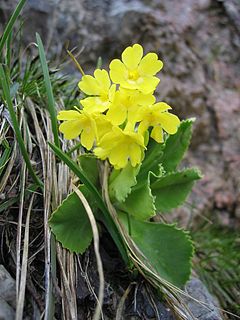
Primula is a genus of herbaceous flowering plants in the family Primulaceae. They include the primrose, a familiar wildflower of banks and verges. Other common species are P. auricula (auricula), P. veris (cowslip), and P. elatior (oxlip). These species and many others are valued for their ornamental flowers. They have been extensively cultivated and hybridised. Primula are native to the temperate Northern Hemisphere, south into tropical mountains in Ethiopia, Indonesia, and New Guinea, and in temperate southern South America. Almost half of the known species are from the Himalayas.

Primula hendersonii is a species of flowering plant in the family Primulaceae, native to western North America, from California north to southern British Columbia and Idaho. Common names include broad-leaved shooting star, Henderson's shooting star, mosquito bills, and sailor caps.

Oxyria digyna is a species of flowering plant in the buckwheat family (Polygonaceae). It is native to arctic regions and mountainous parts of the Northern Hemisphere.

Primula auricula, often known as auricula, mountain cowslip or bear's ear, is a species of flowering plant in the family Primulaceae, that grows on basic rocks in the mountain ranges of central Europe, including the western Alps, Jura Mountains, the Vosges, the Black Forest and the Tatra Mountains.

Pinguicula ramosa is a species of butterwort, a carnivorous plant, endemic to the mountains of Nikkō National Park in Japan. It belongs to the section micranthus and is closely related to Pinguicula variegata. It is unique in the genus for having a forked flower stalk.

Protea neriifolia, also known as the narrow-leaf sugarbush, oleander-leaved sugarbush, blue sugarbush, or the oleanderleaf protea, is a flowering plant in the genus Protea, which is endemic to South Africa.

Primula pauciflora, the pretty shooting star, few-flowered shooting star, dark throat shooting star or prairie shooting star, is a species of flowering plant in the primula family Primulaceae. It is a widespread and very variable species, native to western North America, from Subarctic America to Mexico, often in xeric and desert habitats. It is found in the Great Basin Deserts and Mojave Desert. Its synonyms include Dodecatheon pauciflorum and Dodecatheon pulchellum.

Protea aristata is a compact shrub with beautiful flowers which is endemic to the southwestern part of the Cape Region of South Africa. P. aristata has become one of South Africa's most famous proteas in spite of its relatively late discovery, and re-discovery in 1953. The leaves are soft, dense and needle-like and the flower heads are a stunning crimson red, it may thus be a good potential ornamental plant for South African gardens. It is usually called the Ladismith sugarbush in South African English, although it has been called pine sugar bush in Australia. In the Afrikaans language it has the vernacular name of klein-den-suikerbos.

Cortusa is a formerly recognized genus in the family Primulaceae. It is now regarded as a synonym of the genus Primula. It consisted of about 19 species of delicate, hardy, alpine perennials. The genus was named by the herbalist Matthiolus after his friend Cortusus, professor of botany at Padua, who discovered the plant originally called Cortusa matthioli (now Primula matthioli. The plants are flowering herbaceous perennials native to the mountains of southern and eastern Europe, including the Alps and the Carpathians, with some species native to China. Most of the species are small spring bloomers for shade and rock garden. These low-growing and rather handsome little plants have clumps of downy, light green, heart-shaped leaves with serrated edges. In late spring, small loose umbel of delicate bell-shaped to lily-liked flowers born terminally on drooping spikes arise from the base, some 6-8in high. Flowers are magenta, pink, white and yellow. They are dormant in some months, and as spring begins, stems and leaves quickly start to reproduce.

Androsace vitaliana is a species of plant in the primrose family, Primulaceae. It was previously known by the synonym Vitaliana primuliflora. Native to the high mountains of Europe, it is cultivated as an alpine garden plant, being considered easy to grow in well drained soil in a sunny position.

Protea nana, also known as the mountain rose or mountain-rose sugarbush, is a flowering shrub which belongs within the genus Protea.

Primula nutans, also known as the sleepy primrose, is a species of flowering plant belonging to the family Primulaceae.

Primula stricta, also known as the strict primrose, is a species of flowering plant in the family Primulaceae.

Primula scandinavica is a species of flowering plant in the family Primulaceae.

Primula algida is a species of flowering plant within the family Primulaceae. This species was first described by Michael Friedrich Adams.

Paeonia coriacea, also known as the Corsican peony or Andalusian peony, is a species of flowering plant within the family Paeoniaceae.
Primula heucherifolia is a species of flowering plant in the family Primulaceae.

Paeonia arietina is a species of flowering plant within the family Paeoniaceae.

Viola gracilis, also known as the Olympian violet, is a species of flowering plant within the family Violaceae.
Primula boveana, also known as the Sinai primrose, is a species of flowering plant within the family Primulaceae. The species was named in honour of botanist and plant collector Nicolas Bové.


















